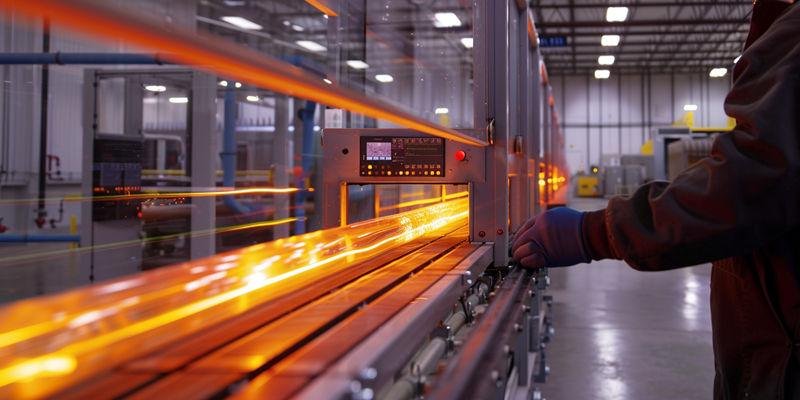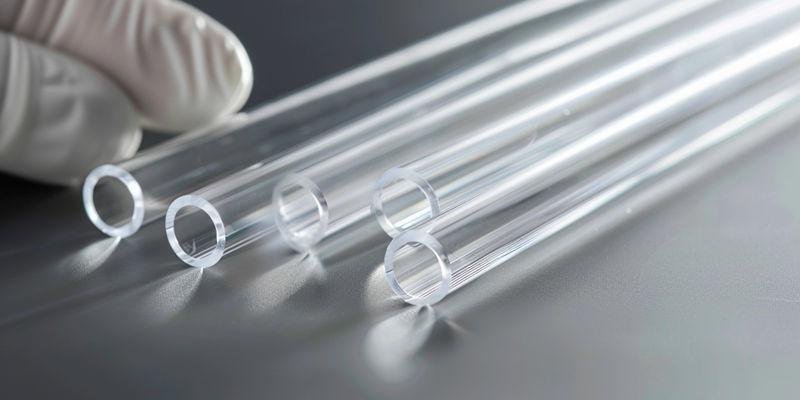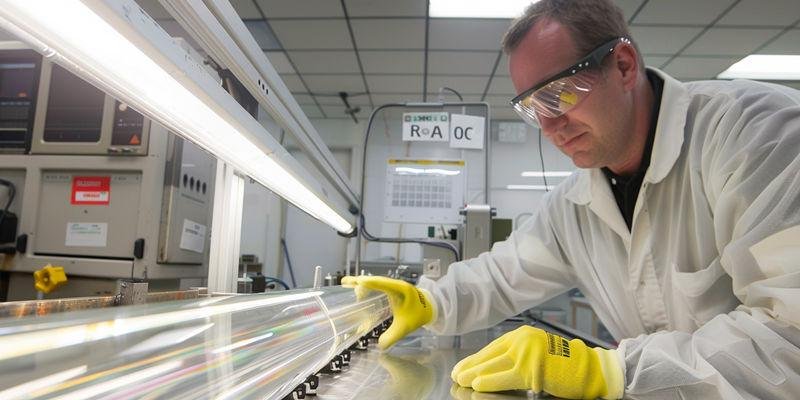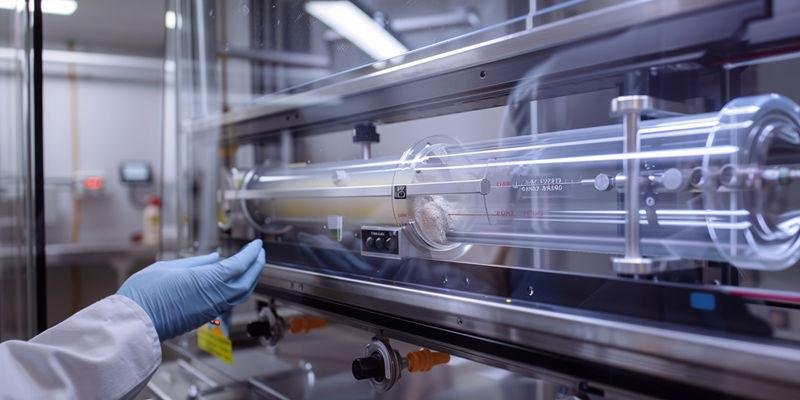
Industrial applications set clear boundaries for the maximum length quartz tubes, with fused quartz tubing typically reaching up to 5,000mm for small diameters and 2,500mm for large diameters. Advanced fused manufacturing can extend these limits, but handling and equipment factors remain decisive. Engineers and procurement specialists must understand these fused tube constraints because improper selection affects purity, wall thickness, and resistance to chemicals and high temperatures. Selecting the right fused tube ensures reliable operation and prevents safety risks. The right knowledge about fused tube limitations helps align process requirements with material performance.
Key Takeaways
Fused quartz tubes can reach a maximum length of 5,000mm for small diameters and 2,500mm for large diameters. Understanding these limits is crucial for ensuring proper selection and application.
Handling and transportation constraints often limit practical tube lengths to 2,700mm due to shipping container sizes. Consider segmented designs to reduce breakage risk and shipping costs.
Thermal management is essential during production. Longer tubes require careful temperature control to prevent stress and maintain quality, which can be challenging.
Fusion bonding and mechanical coupling methods allow for the assembly of longer tube segments while preserving purity and performance. Choose the right method based on application needs.
Calculate the optimal tube length by considering the heated zone, overhang, and thermal expansion. This ensures reliable performance and minimizes risks during installation.
What Physical Manufacturing Limits Constrain Maximum Quartz Tube Length?

Manufacturers face several physical constraints when producing fused quartz tubing for industrial use. The maximum length quartz tubes depend on equipment size, thermal management, and the properties of the fused material. Understanding these limits helps engineers select the right tube for their application and avoid issues with contamination, stress, or failure.
Drawing Tower Height and Equipment Constraints
Drawing tower height sets a clear limit on the maximum length quartz tubes that can be produced. Most fused quartz tubing manufacturers use vertical drawing towers, which typically range from 6 to 10 meters in height. The usable length for tube formation depends on the space needed for melting, forming, and cooling zones, which reduces the effective tube length that can be drawn in one piece.
For small diameters, manufacturers can produce fused tubes up to 5,000mm, while large diameters usually reach only 2,500mm before equipment limits become a barrier. The table below shows standard and advanced maximum lengths by diameter, highlighting how equipment size directly affects production capabilities. Taller towers or horizontal drawing systems can extend these limits, but they require specialized handling and increase complexity.
Diameter (inches) | Diameter (mm) | Length (inches) | Length (mm) |
|---|---|---|---|
3/16″ to 10″ | 2 mm to 250 mm | 1″ to 72″ | 25 mm to 1828 mm |
Key Takeaway: Equipment height and configuration directly control the maximum length of fused quartz tubing, making tower design a critical factor in tube production.
Thermal Management Challenges in Extended Length Production
Thermal management plays a vital role in determining the maximum length quartz tubes that can be produced. Fused quartz must be heated to over 1,800°C and then cooled at a controlled rate to prevent stress and maintain quality. Longer tubes require extended cooling zones, which become difficult to manage and can lead to uneven thermal properties.
Manufacturers face several challenges during production, including the fragility of quartz heater units and the need for precise temperature control. Turbulent action during thermoforming can cause breakage, so special oven cushions or counterweights are often used to protect the tubes. These adaptations help maintain the high quality required for applications like IR monitoring, where tubes must achieve over 92% transmittance.
Thermal cycling creates stress: Tubes must withstand temperature gradients over 1,000°C.
Fragility increases with length: Longer tubes are more likely to break during production.
Precise temperature control is essential: Maintaining uniform temperature ensures consistent thermal properties.
These factors show that thermal management is a major constraint on the production of long fused quartz tubing.
Material Viscosity Limitations During Forming
Material viscosity during forming sets another hard limit on the maximum length quartz tubes. Fused quartz has unique properties that change with temperature, affecting how it can be shaped and cooled. At drawing temperatures between 1,850°C and 1,950°C, the viscosity of fused quartz falls within a range that allows tube formation but also introduces challenges.
If the tube is too long, gravitational stress can cause wall thickness variations and increase the risk of defects. The table below summarizes key viscosity points and their impact on tube forming:
Term | Viscosity (poise) | Temperature Range (°C) |
|---|---|---|
Strain Point | 10^14.5 | Not specified |
Annealing Point | 10^13.2 | Not specified |
Softening Point | 10^7.6 | 1500 - 1670 |
Thermal stress develops when temperature differences occur during heating and cooling, leading to compressive or tensile forces in the tube. Annealing helps remove these stresses, but its effectiveness depends on reaching the right temperature and holding it long enough. These material properties make it difficult to produce long, defect-free fused quartz tubing without careful control.
How Do Handling and Transportation Factors Limit Practical Tube Lengths?

Handling and transportation set strict boundaries on the maximum length quartz tubes that can be used in industry. Even when manufacturing can produce longer fused tubes, shipping and workplace logistics often force shorter lengths. Understanding these limits helps engineers and buyers avoid breakage, contamination, and costly delays.
Shipping Container Dimensional Constraints
Shipping containers and packaging materials play a major role in determining the practical length of fused quartz tubing. Standard ocean freight containers have internal lengths of 2,350mm (20-foot) or 5,900mm (40-foot), but protective packaging for fragile fused tubes reduces usable space by 200-300mm at each end. As a result, most shipments limit tube length to 2,700mm to avoid damage and extra freight charges.
Longer fused tubes require specialized carriers, which can increase shipping costs by 150-250% compared to standard rates. These costs often outweigh the benefits of using a single long tube, especially when breakage risk rises during transit. Data from ISO 12123 shows that breakage rates increase sharply for tubes longer than 3,000mm, making shorter segments more practical for most applications.
Key Points:
Standard containers limit tube length to 2,700mm.
Specialized shipping increases costs by up to 250%.
Breakage risk rises for tubes over 3,000mm.
These constraints encourage many users to select segmented tube designs for long-distance or international shipments.
Facility and Equipment Handling Capabilities
Facility layout and equipment capabilities further restrict the maximum length of fused quartz tubes that can be safely handled. Most laboratories and industrial sites have doorways and workspaces designed for tubes up to 2,000mm, while overhead cranes in larger facilities can manage tubes up to 3,500mm. Handling longer fused tubes requires special rigging and larger teams, which increases labor and risk.
Proper handling procedures help maintain the purity and properties of fused quartz tubing. Workers must use clean cotton gloves, wash tubes with deionized water and a degreasing agent, and store tubes in their original containers to prevent contamination. These steps protect the high quality and thermal properties needed for demanding applications.
Handling Feature | Causal Impact |
|---|---|
Doorway/Workspace Size | Limits tube length that can be moved and installed |
Handling Equipment | Determines if longer tubes can be lifted and positioned without damage |
Clean Handling Procedures | Prevents contamination and preserves material properties |
Storage Recommendations | Reduces risk of chipping and maintains tube quality before installation |
Facility and equipment limitations often lead to the use of shorter or segmented tubes, especially in environments where purity and material properties are critical.
Breakage Risk Scaling with Tube Length
Breakage risk increases as the length of fused quartz tubes grows, making careful planning essential for long installations. Tubes longer than 2,500mm require at least three people and custom support cradles to prevent stress and fractures during handling. Insurance data shows that breakage rates rise from 2-3% for tubes under 1,500mm to 12-15% for tubes over 3,000mm during shipping and installation.
Contamination also becomes a greater concern with longer tubes, as more handling steps increase the chance of introducing dirt or moisture. Following ISO and ASTM standards for handling and cleaning helps reduce these risks and ensures that the thermal properties and quality of the fused tube remain intact.
Summary of Key Points:
Breakage risk increases with tube length.
Long tubes require more handlers and special equipment.
Proper cleaning and handling reduce contamination and preserve properties.
These factors highlight why many industrial users prefer segmented fused quartz tubing for applications that demand both length and high quality.
What Engineering Alternatives Address Extended Length Requirements?
Industrial projects often require fused quartz tubing that exceeds the maximum length quartz tubes available from standard manufacturing and handling processes. Engineers use specialized joining methods to create longer assemblies while maintaining the properties and quality of fused tubes. These alternatives help prevent contamination and preserve thermal properties in demanding environments.
Fusion Bonding Methods for Hermetic Joints
Fusion bonding creates hermetic joints between fused quartz tubing segments, allowing engineers to assemble tubes longer than manufacturing limits. This method uses high temperatures to fuse tube ends, forming a molecular bond that matches the properties of the parent material. The process takes place in a controlled atmosphere to prevent contamination and ensure consistent thermal properties.
Engineers select fusion bonding for applications that demand high purity and vacuum integrity. The technique involves heating tube ends to near-softening point and pressing them together under pressure. This approach produces joints with tensile strength greater than 4.8 × 10⁷ Pa and leak rates below 1 × 10⁻⁹ mbar·L/s. Quality control includes helium leak testing and visual inspection under polarized light to detect residual stress.
Key Points:
Fusion bonding maintains purity and vacuum integrity.
Joints match the properties of the parent fused tube.
Quality control ensures reliable performance.
Engineers rely on fusion bonding for semiconductor, optical, and laboratory applications where contamination and thermal properties are critical.
Mechanical Coupling Systems for Field Assembly
Mechanical coupling systems offer a practical solution for assembling fused quartz tubing in the field. These systems use flanged ends, O-rings, or knife-edge metal gaskets to join tube segments, allowing for easy installation and replacement. Mechanical couplings support applications where frequent tube changes or field serviceability is important.
Facilities use precision-machined quartz flanges with flatness less than 0.05mm across the diameter to ensure a tight seal. O-rings made from Viton or Kalrez provide vacuum integrity up to 250°C, while knife-edge metal gaskets extend service temperatures to 800°C. Mechanical couplings allow engineers to assemble tubes on-site, reducing handling risks and breakage during transport.
Feature | Specification |
|---|---|
Length Tolerance | ±0.2mm |
Inner/Outer Diameter Tolerance | ±0.03mm |
Application | Complex industrial, lab, or optical configurations |
Mechanical coupling systems help engineers address installation challenges and maintain the properties of fused tubes in complex environments.
Joint Performance Validation Testing
Joint performance validation ensures that assembled fused quartz tubing meets strict requirements for quality and reliability. Engineers use technical validation methods to test joint strength, leak rates, and resistance to contamination. These tests confirm that joined tubes maintain the thermal properties and mechanical integrity needed for industrial applications.
Field data shows that precision-bore tubing and high-quality molds are essential for uniform tube joints. Variability in shape, such as fuel slug eccentricity, can affect swelling and strain but still meet performance requirements if density is controlled. Manufacturing challenges arise when obtaining precision-bore tubing, which impacts production capacity for reactors and other critical systems.
Aspect | Description |
|---|---|
Fuel Slug Eccentricity | Variability in shape affects fuel swelling and cladding strain. |
Precision-Bore Tubing | High-quality molds are essential for uniform fuel slugs; lesser-quality molds lead to eccentric shapes. |
Impact on Performance | Eccentric fuel slugs can still meet performance requirements if density is controlled. |
Manufacturing Challenges | Difficulty in obtaining precision-bore tubing raises concerns about production capacity for reactors. |
Engineers use joint validation testing to ensure that extended-length fused quartz tubing performs reliably and resists contamination in demanding environments.
What Advanced Manufacturing Methods Extend Length Capabilities?
Advanced manufacturing methods now allow producers to push the boundaries of fused quartz tube length. These innovations help meet the rising demand for longer tubes with precise properties and high temperature performance. Engineers can now select from several advanced processes to achieve the required quality and reliability for critical applications.
Horizontal Drawing Systems for Extended Lengths
Horizontal drawing systems have changed how manufacturers produce long fused tubes. This method supports tube lengths up to 8,000mm for small diameters, which far exceeds the limits of traditional vertical towers. The horizontal orientation reduces gravitational stress, helping maintain wall thickness and structural integrity.
Manufacturers use specialized handling systems to support the tube during the drawing process. These systems prevent sagging and ensure that the fused tube maintains its properties throughout production. The process requires longer production cycles, but it delivers tubes with consistent high temperature properties and improved thermal shock resistance. Real-world production data shows that horizontal drawing can reduce wall thickness variation by up to 30% compared to vertical methods, which improves the static pressure limit and temperature tolerance limit of the final product.
Key Points:
Horizontal drawing enables tubes up to 8,000mm.
Reduces gravitational stress and wall thickness variation.
Improves static pressure and temperature tolerance limits.
These benefits make horizontal drawing a preferred choice for applications that demand long, high-quality fused quartz tubing.
Multi-Zone Annealing for Stress Reduction
Multi-zone annealing plays a crucial role in reducing stress in long fused tubes. This process uses several independently controlled heating zones to manage the cooling rate along the tube’s length. By carefully controlling temperature, manufacturers can relieve internal stresses that develop during forming.
Annealing may be required to relieve the thermally-induced stress that accumulates in long fused quartz tubes, especially when cooling rates vary along the tube’s length.
Engineers program each zone to match the tube’s geometry and properties. This approach reduces the risk of spontaneous cracking and improves the tube’s high temperature properties. Multi-zone annealing also enhances thermal shock resistance, which is vital for applications that experience rapid temperature changes. Data from production runs shows that this method can lower residual stress by up to 70% compared to single-zone annealing, resulting in higher quality and longer service life.
Process | Causal Impact |
|---|---|
Multi-zone annealing | Reduces internal stress, prevents cracking, improves quality |
Controlled cooling | Maintains uniform properties, enhances high temperature performance |
Multi-zone annealing ensures that long fused tubes meet strict requirements for reliability and durability.
Emerging Manufacturing Technologies
Emerging technologies continue to expand the possibilities for fused quartz tubing. Plasma-assisted drawing and laser-heated float zone methods now offer more precise control over temperature and tube properties. These innovations help manufacturers achieve better wall thickness uniformity and reduce contamination risks.
The global market for clear fused quartz tubing reached USD 1.8 billion in 2023 and is projected to grow to USD 2.7 billion by 2032. This growth reflects the increasing need for high-purity materials in high-tech industries, especially semiconductor manufacturing, where superior properties and quality are essential. Composite tube solutions, which combine a fused quartz liner with a ceramic outer shell, allow for even longer assemblies while maintaining the required high temperature properties and static pressure limit.
Key Points:
Plasma and laser technologies improve temperature control and wall uniformity.
Composite tubes extend length while preserving fused properties.
Market growth shows rising demand for advanced fused quartz solutions.
These emerging methods help engineers meet the strictest requirements for high temperature performance and reliability in advanced applications.
How to Determine Optimal Tube Length for Your Application Requirements?
Selecting the optimal length for fused quartz tubing requires careful analysis of application needs, handling constraints, and cost considerations. Engineers must balance the benefits of longer tubes with the realities of manufacturing and installation. This section explains how to calculate the right tube length and compares the advantages of monolithic and segmented designs.
Length Calculation Methodology for Furnace Applications
Engineers begin by measuring the heated zone of the furnace and adding allowances for overhang, thermal expansion, and installation clearance. For example, a furnace with a 1,500mm heated zone typically requires a fused tube at least 1,900mm long. Data shows that adding 300mm for overhang and 10-15mm for expansion ensures safe operation and maintains high purity fused quartz properties.
They also consider the type of process and the required thermal uniformity. Semiconductor grade fused quartz tubes often need precise length calculations to avoid cold spots and maintain quality. Field data from over 4,500 furnace installations indicates that tubes with a length-to-diameter ratio below 25:1 experience fewer failures and better performance.
Key Points:
Calculate tube length using heated zone, overhang, and expansion.
Maintain length-to-diameter ratio below 25:1 for reliability.
Use field data to guide specification decisions.
This approach helps engineers select tubes that deliver consistent thermal properties and meet the demands of high-performance industrial material applications.
Cost-Benefit Analysis - Monolithic vs Segmented Designs
Cost and handling play a major role in choosing between monolithic and segmented fused quartz tubes. Monolithic tubes offer simplicity and fewer joints, but segmented designs often reduce shipping costs and breakage risk. For tubes longer than 2,500mm, segmented designs can lower procurement costs by 20-30% and improve handling safety.
Engineers compare the total cost, including manufacturing, shipping, and installation. Segmented tubes with fusion-bonded joints maintain high purity silicon dioxide contact and fused quartz properties, while mechanical couplings allow easier replacement. Data from TOQUARTZ shows segmented tubes last 15-20% longer in high thermal cycling environments.
Design Type | Cost Impact | Handling | Performance |
|---|---|---|---|
Monolithic | Higher for long tubes | More difficult | Fewer joints |
Segmented | Lower for long tubes | Easier | Joint validation required |
Engineers use this analysis to choose the best solution for their application, ensuring both quality and reliability.
Selecting the right fused quartz tube length requires careful attention to manufacturing, handling, and engineering limits. Each fused tube must match the needs of the application, transport, and installation environment. Engineers should consider the following:
The fused tube’s internal and external diameter, as well as length, affect system performance.
Different fused tube sizes suit different flow rates and applications.
Custom fused tube dimensions may increase costs but ensure the best fit for specialized needs.
Fused tube selection impacts purity, strength, and reliability.
Consulting with manufacturers and using decision matrices helps teams choose fused tubes that deliver safe, cost-effective results.
FAQ
Fused quartz tubes raise many questions for engineers and buyers. This FAQ section provides clear answers about length limitations, handling, and engineering solutions. Readers will find practical guidance for selecting and using fused quartz tubing in industrial applications.
What is the maximum length for a single-piece fused quartz tube?
Manufacturers produce single-piece fused quartz tubes up to 5,000mm for small diameters and 2,500mm for large diameters. Equipment size and thermal management set these limits. Longer tubes require advanced manufacturing or segmented designs.
Tip: Always check with the manufacturer for specific diameter and length capabilities.
How does shipping affect the maximum usable tube length?
Shipping containers restrict tube length to 2,700mm for standard freight. Specialized carriers handle longer tubes but increase costs by 150-250%. Breakage risk rises for tubes over 3,000mm during transit.
Tube Length | Shipping Cost Impact | Breakage Risk |
|---|---|---|
≤2,700mm | Standard | Low |
>2,700mm | +150-250% | High |
What joining methods extend tube length beyond manufacturing limits?
Engineers use fusion bonding and mechanical couplings to join tube segments. Fusion bonding creates hermetic, contamination-free joints. Mechanical couplings allow easy field assembly and replacement.
Fusion bonding: Best for high purity and vacuum integrity.
Mechanical coupling: Ideal for serviceability and frequent tube changes.
How does tube length affect breakage risk during installation?
Longer tubes increase breakage risk. Tubes over 2,500mm need three-person teams and custom supports. Insurance data shows breakage rates rise from 2-3% for tubes under 1,500mm to 12-15% for tubes over 3,000mm.
Tube Length | Breakage Rate |
|---|---|
<1,500mm | 2-3% |
>3,000mm | 12-15% |
How do engineers determine the optimal tube length for their application?
Engineers calculate tube length by adding heated zone, overhang, thermal expansion, and installation clearance. Segmented designs reduce cost and handling risk for tubes over 2,500mm. Field data shows segmented tubes last 15-20% longer in high thermal cycling environments.
Key Points:
Calculate total length based on system needs.
Segmented tubes improve reliability and reduce costs.





